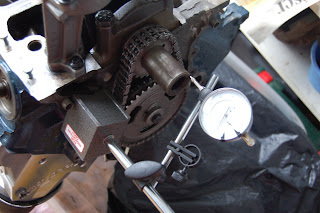First task was to measure the endfloat of the camshaft and crankshaft as these values are critical for proper lubrication.
Pressing my new Dial Test Indicator (DTI) into service, I was able to check that these measurements were within specification and so could move onto ‘degreeing’ the camshaft. For those unfamiliar with the job, this means checking the cam timing against the crank angle and involves fitting an angle gauge to the crank (aligned with number 1 piston) and measuring the angle of maximum lift of the corresponding intake and exhaust tappets (lifters). These angles may not be quite as the manufacturer intended due to component tolerances of the specific engine being built and there is an amount of adjustment in the system to allow for compensation.
My cam timing came out to be around 1.5 degrees late, but since the three adjustment positions I had available it 0, +4 degrees or -4 degrees (I have not seen a vernier cam sprocket for these engines that will fit under the stock timing cover), this was a close as I was going to get! Next up was fitting the oil pump which needed modification in order for the mounting bolts to sit flat. Fortunately, the milling machine at work had been available for such a job and made light work of the task.
Fitting the oil pickup pipe finished off that part of the assembly and with one last torque check of the bolts, I could move onto closing up the oily bits of the engine.This started with the timing chain cover then the sump followed by the water pump. These were relatively simple tasks, but since I am using a random collection of original equipment, reproduction and aftermarket parts, some of the fastener kits don’t have the correct bolts so I need to purchase some additional hardware before I can finish this off.
I am now at the stage where I need to procure the parts I have designed for adding the fuel injection components before I can progress the engine build any further. I suspect it may be a little while before the planets align again, so it is not too much of a rush!






Nice!
ReplyDeleteCould you give more info on the oil pump shaft that replaces the dizzy? I'm thinking of going coil packs but not found anything about for our older engines.
I used a cam position sensor (found on sequenced fuel injection engines) which replaced the dizzy on later versions of the small block Ford: http://www.summitracing.com/parts/RNB-689-103
DeleteI'm not using it as a sensor as I will only be batch firing my injectors, but it plugs the dizzy hole and the drive gear meshes with the cam to drive the oil pump shaft which is a stock replacement part. Bear in mind you have to get the right combination of gears between the cam and oil pump shaft (hardened / 'soft') otherwise they will wear out quickly.